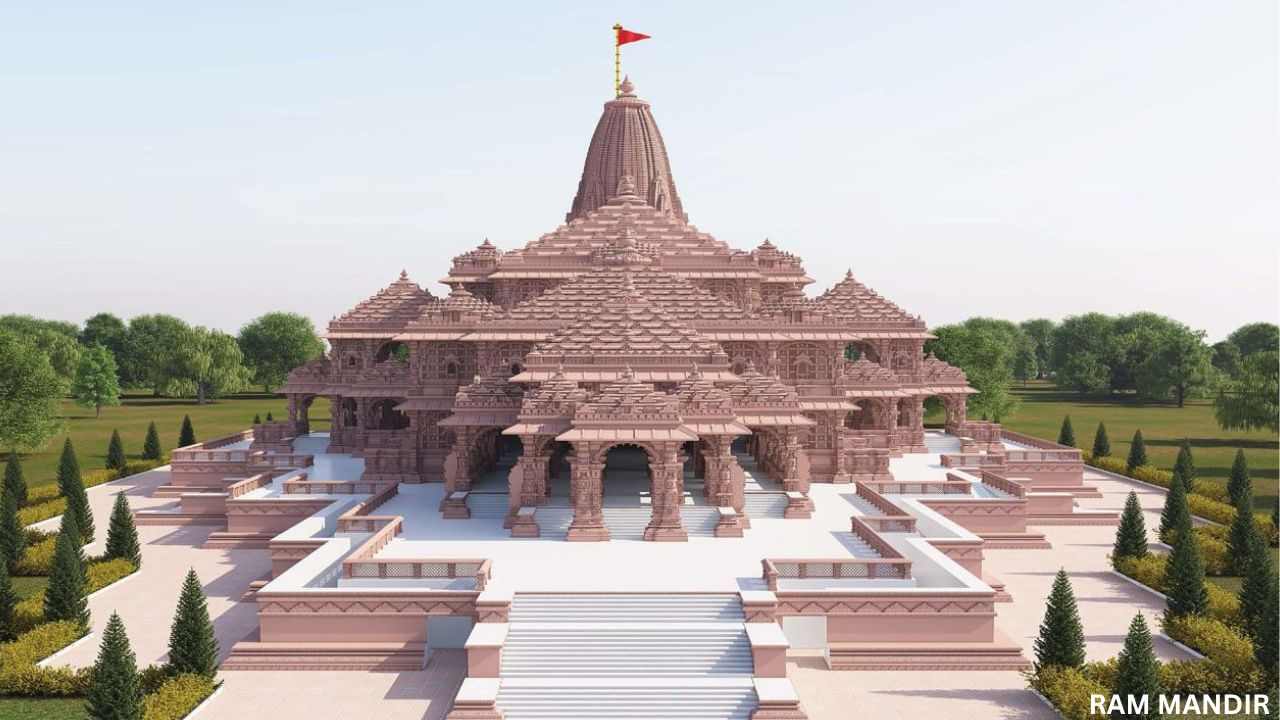The Ayodhya Ram Mandir, also referred to as the Lord Ram Temple, stands as a prominent Hindu temple situated in Ayodhya, Uttar Pradesh, India. This temple has been at the heart of an enduring religious and political conflict within the country. In the following text, we will delve into the temple’s historical background, architectural features, cultural importance, and directions on how to access the Ayodhya Ram Mandir.
History Of Ayodhya Ram Mandir
The history of the Ayodhya Ram Mandir is steeped in centuries of tradition. This temple stands on what is believed to be the sacred birthplace of Lord Ram, one of Hinduism’s most revered deities.
In the 16th century, during the reign of the Mughal emperor Babur, the original temple was demolished, and in its place, a mosque known as the Babri Masjid was constructed. For many generations, this mosque occupied the site, coexisting with the rich tapestry of India’s religious landscape.
However, in 1992, the Babri Masjid was tragically demolished by Hindu nationalists, sparking widespread violence and communal tensions across the country.

The Ayodhya dispute had long been a contentious issue in Indian politics, revolving around the ownership of the site where the Babri Masjid once stood and whether it indeed marked the birthplace of Lord Ram.
The dispute persisted for decades until the Indian Supreme Court issued a landmark verdict in 2019. The court ruled in favor of the construction of a Ram Janmabhoomi temple on the disputed site. To oversee this historic endeavor, the Indian government established the Shri Ram Janmabhoomi Teerth Kshetra trust, entrusted with the responsibility of constructing the temple.
The construction of the Ayodhya Ram Mandir, therefore, represents a significant step in the resolution of a contentious and deeply rooted issue, one that has been at the intersection of religion, history, and politics in India for generations.
Building Design and Features of the Ayodhya Ram Mandir
The Ayodhya Ram Mandir is an architectural marvel that beautifully blends traditional Indian temple design with intricate craftsmanship. Below, I’ll elaborate on the architecture and notable features of the temple:

Nagara Temple Architecture
- The temple follows the Nagara style of temple architecture, which is characterized by its tall, curvilinear spires or shikhara. These shikhara are a prominent feature of North Indian temples and symbolize reaching towards the divine.
Pink Sandstone Construction
- The temple is constructed primarily using pink sandstone, a material often used in North Indian temple architecture. This sandstone gives the temple its distinct rosy hue and imparts a regal and timeless quality to the structure.
Size and Layout
- The temple complex spans an expansive area of 2.77 acres, making it a grand and spacious site for devotees. The complex also includes a vast courtyard, enhancing its visual appeal and providing room for religious gatherings.
Shaligram Stone
- The temple’s most striking feature is the giant Shaligram stone, a black stone believed to represent Lord Ram. This sacred stone was brought from the Gandaki River in Nepal, adding a significant element of spirituality to the temple.
Towering Height
- The Ayodhya Ram Mandir soars to an impressive height of 161 feet, making it a dominant presence in the cityscape. The towering spires and intricate carvings contribute to the temple’s grandeur.
Three Floors with Different Purposes
- The temple is organized into three floors, each dedicated to a different deity and purpose.
- The first floor is dedicated to Lord Ram and serves as the primary place of worship for devotees.
- The second floor pays homage to Lord Hanuman, a beloved deity in Hinduism and a devotee of Lord Ram.
- The third floor houses a museum, offering insights into the history and culture of Ayodhya. This section enhances the visitor’s understanding of the city’s rich heritage.
Yajnashala (Hall for Fire Rituals)
- The temple complex includes a yajnashala, a hall designed for conducting yajnas, which are Hindu fire rituals. Yajnas hold a significant place in Hindu religious practices.
Community Kitchen
- The temple complex features a community kitchen, a symbolic representation of seva (selfless service) in Hinduism. Volunteers often prepare and serve free meals to visitors, reflecting the ethos of compassion and hospitality.
Medical Facility
- In keeping with the values of care and well-being, the temple complex includes a medical facility to provide healthcare services to devotees and visitors.
Cultural and Religious Hub
- The temple complex spans a vast area of 67 acres, and it is expected to become a major cultural and religious center. It is likely to attract millions of devotees from around the world who seek spiritual solace and cultural enrichment.
The Ayodhya Ram Mandir, with its Nagara-style architecture, artistic features, and spiritual significance, stands as a testament to India’s rich architectural heritage and the enduring devotion of millions of followers of Lord Ram.
The Dispute over the Ram Mandir
The dispute over the Ram Mandir is about the ownership of the land in Ayodhya, where the temple is located. Here are more details in simpler words:
1. Birthplace Belief: Some people, especially Hindus, believe that this land is the exact place where Lord Ram, a very important god to them, was born. They want to build a temple there to honor him.
2. Old Mosque: On the other hand, there was a mosque called the Babri Masjid that stood there for many years. Some people, mainly Muslims, say that this mosque was built according to the rules and should continue to exist.
3. Historical Tension: This argument about who should have the land has been going on for a very long time and has caused fights and disagreements between different groups of people. It has been a big problem in India.
What Was the Supreme Court Decision on This Dispute
The Supreme Court Decision, also known as the Ayodhya Verdict, was a landmark judgment delivered by the Supreme Court of India in November 2019.
Background: The Supreme Court was tasked with settling a long-standing dispute over the ownership of the land in Ayodhya, where the Babri Masjid once stood. The dispute centered on whether a Hindu temple should be built there or if the mosque should be allowed to remain.
The bench of Judge: The bench that gave the decision in the Ayodhya case was led by the then Chief Justice of India, Ranjan Gogoi. The bench also included Justices S.A. Bobde, Dhananjaya Y. Chandrachud, Ashok Bhushan, and S. Abdul Nazeer.

The Verdict: The Supreme Court ruled that the land should be handed over to the Hindus to build a temple dedicated to Lord Ram, a significant deity in Hinduism. The court also ordered the allocation of an alternate piece of land to the Muslims to construct a mosque.
Significance: This decision put an end to the contentious issue that had caused social and political tensions in India for decades. It aimed to provide a legal resolution to the dispute, addressing the concerns of both the Hindu and Muslim communities.
The Supreme Court Decision in the Ayodhya case was considered a significant step in the direction of resolving a longstanding dispute through legal means and promoting peace and harmony in the country.
What Does Ayodhya Ram Mandir Mean To Hindu
The Ayodhya Ram Mandir is a very special place for Hindus. They believe it’s where Lord Ram was born, and they consider it very holy. It’s also a big win for them because they’ve been trying to build this temple for a long time.
This temple is going to make Ayodhya a popular place for people to visit. It will create jobs and help the city grow. Lots of people from India and other countries will come to visit, which will make Ayodhya an even more important religious and cultural place.
Inauguration Ceremony of Ayodhya Ram Mandir
Swami Govind Dev Giri Maharaj, who is the treasurer of the Shri Ram Janmabhoomi Teerth Kshetra Trust, shared that the special ceremony to place the idol of Lord Ram in Ayodhya is planned for January 22, 2024, at 12:20 p.m. They are expecting around 7,500 people to be part of this significant event, including 5,000 sadhus (holy people) and saints. It’s a significant and awaited occasion for many.
PM Modi In Inauguration Ceremony of Ayodhya Ram Mandir
Prime Minister Narendra Modi is going to attend the opening ceremony, and he expressed how special it is for him to be part of this historic event. During the ceremony, the prime minister will do something called “Pran Pratishtha,” which is a way to honor the rich history and culture of our nation.
Other important people like RSS Chief Mohan Bhagwat and the Chief Minister of Uttar Pradesh, Yogi Adityanath, will also be there.
Right now, they are making three idols that show Lord Ram as a child, and they will choose one for the temple. The celebrations are set to begin on January 17, 2024, and the temple will be open to everyone on the evening of January 22, 2024, or the morning of January 23, 2024.
Ayodhya is getting ready for a lot of visitors, and they’re expecting over one lakh (100,000) people to visit the temple in just one day.
How Can You Reach To Ayodhya Ram Mandir?
Getting to Ayodhya is quite convenient as it’s well-connected by road, rail, and air:
By Air
- The nearest airport is the Chaudhary Charan Singh International Airport in Lucknow, about 135 km from Ayodhya.
- From the airport, you can either take a taxi or a bus to reach Ayodhya.
By Train
- Ayodhya has its railway station, and it’s connected to major cities across India. You can take a train from places like Delhi, Mumbai, Kolkata, and more.
- Once you reach the railway station in Ayodhya, you can hire a taxi or hop on a local bus to get to the temple.
By Road
- Ayodhya has good road connections to major cities in Uttar Pradesh. You can travel by bus or hire a taxi from cities like Lucknow, Varanasi, and others to reach Ayodhya.
So, you have different options to reach Ayodhya depending on your preference and starting location.
Conclusion
The Ayodhya Ram Mandir is much more than just a temple. It’s a symbol of people’s belief, unity, and culture. Building this temple is a huge moment in India’s history because it shows that truth, fairness, and goodness have won.
This temple stands as proof of the unwavering devotion of the Hindu community to Lord Ram. It’s a place where people come to pray and feel inspired.
For a long time, this temple was at the center of a religious and political argument in India. But now, with the temple built, the argument is settled, and the place belongs to the people who wanted to build the temple.
The Ayodhya Ram Mandir is a place of hope and inspiration, reminding us how strong belief and the human spirit can be. As India gets ready to open the temple, it’s going to be a place where people find spiritual and cultural meaning. It’s a sign of India’s rich culture and religious heritage and a way to remember Lord Ram’s enduring legacy.










